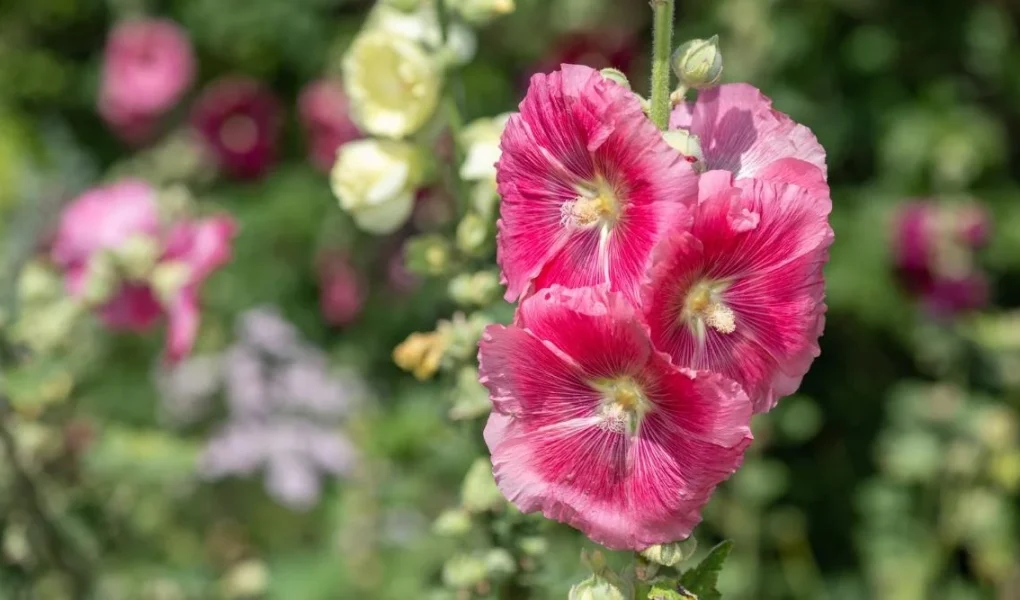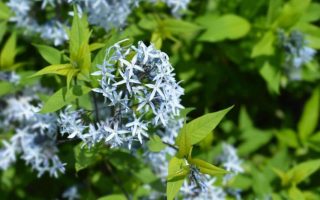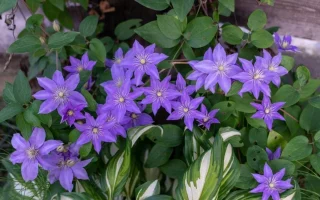lareddepathways.com – The Hollyhock (Alcea rosea) is a striking and classic flower that has been a beloved feature in gardens for centuries. Known for its tall, elegant flower spikes and wide range of vibrant colors, the Hollyhock adds a dramatic and timeless beauty to garden landscapes. With its roots in ancient gardens, the Hollyhock continues to be a favorite among gardeners who seek to add a touch of vintage charm and color to their outdoor spaces. In this article, we will explore the characteristics, care tips, and benefits of growing the Hollyhock flower.
Characteristics of the Hollyhock Flower
Hollyhocks are biennial or perennial plants that grow tall, typically reaching heights of 4 to 8 feet. The plants produce long, upright flower spikes adorned with large, showy flowers in a variety of hues, including pink, red, purple, white, yellow, and even black. Each flower is composed of five petals and has a prominent central stamen that extends beyond the petals, giving it a unique, star-like appearance.
The flowers of the Hollyhock bloom from the bottom of the flower spike upwards, creating a cascading display of color that can last throughout the summer. The leaves of the Hollyhock are large, heart-shaped, and rough in texture, forming a lush base that complements the tall flower stalks. The plant’s ability to produce multiple blooms on a single stem makes it an eye-catching addition to any garden.
Ideal Growing Conditions
Hollyhocks are relatively easy to grow, but they do require specific conditions to thrive. Here are the key factors for successful cultivation:
- Sunlight: Hollyhocks thrive in full sun, requiring at least 6 hours of direct sunlight each day to produce their vibrant blooms. They can tolerate partial shade, but they will not bloom as abundantly.
- Soil: Well-drained soil that is rich in organic matter is essential for Hollyhocks. They prefer slightly acidic to neutral soil and should be planted in loamy or sandy soils. Heavy, clay-based soils can lead to root rot, so proper drainage is key.
- Watering: Regular watering is essential, especially during the growing season. Keep the soil evenly moist, but not waterlogged. Deep watering is preferred over shallow watering to encourage deep root growth.
- Temperature: Hollyhocks thrive in temperate climates and do best in USDA hardiness zones 3 to 9. They are heat-tolerant but can struggle in areas with high humidity. Mild, dry climates are ideal for growing these flowers.
- Fertilizing: Hollyhocks benefit from periodic feeding with a balanced fertilizer to encourage healthy growth and prolific blooms. However, be careful not to over-fertilize, as this can lead to lush foliage growth at the expense of flowering.
Benefits of Growing Hollyhocks
Hollyhocks offer several advantages for gardeners seeking both beauty and function in their landscapes. Some of the key benefits include:
- Dramatic Height and Color: The tall, imposing flower spikes of the Hollyhock can add a vertical element to garden beds, borders, or fences. The variety of colors and large blooms make them a striking focal point in any garden.
- Low Maintenance: Hollyhocks are relatively easy to care for once established. They are drought-tolerant once mature and are resistant to most pests and diseases, making them an excellent low-maintenance option for gardeners.
- Pollinator-Friendly: The large, showy flowers of the Hollyhock attract pollinators such as bees, butterflies, and hummingbirds. Planting Hollyhocks can help support local pollinator populations, which is especially important in today’s gardens.
- Versatile Landscaping: Whether planted along a fence line, in the back of a flower border, or as part of a cottage-style garden, Hollyhocks add a vintage charm to a variety of garden styles. Their upright growth and abundant blooms make them perfect for creating colorful vertical accents in the garden.
Creative Garden Uses
The tall stature and beautiful blooms of Hollyhocks make them incredibly versatile in garden design. Here are some creative ways to incorporate Hollyhocks into your landscape:
- Garden Borders: Plant Hollyhocks at the back of a flower bed or along garden borders where their tall flower spikes can provide height and structure. Their vibrant blooms will add color and drama to the backdrop of shorter plants.
- Cottage Gardens: Hollyhocks are a staple in traditional cottage gardens, where their vintage charm pairs beautifully with other cottage-style plants like roses, foxgloves, and delphiniums. The flowers’ rustic appearance complements the informal, romantic style of this gardening aesthetic.
- Fence Lines: Hollyhocks make an excellent choice for planting along fences or walls. Their height and upright growth can create a beautiful, colorful screen or backdrop that adds visual interest to your outdoor space.
- Cut Flowers: The long, elegant flower spikes of Hollyhocks make them an ideal choice for cut flowers. They last well in floral arrangements and can be used in both fresh and dried flower bouquets.
- Pollinator Gardens: Since Hollyhocks attract bees, butterflies, and other beneficial insects, they are perfect for a pollinator-friendly garden. Planting them alongside other nectar-rich flowers can help create a haven for pollinators.
Conclusion
The Hollyhock flower is a classic and timeless beauty that adds height, color, and charm to any garden. With its tall flower spikes, wide range of vibrant hues, and ease of care, the Hollyhock is an excellent addition to both traditional and contemporary gardens. Whether you are growing them as a focal point, as part of a flower border, or in a cottage-style garden, these striking flowers are sure to bring joy and drama to your outdoor space for many seasons to come.




